Responses of single corticospinal neurons to intracortical stimulation of primary motor and premotor cortex in the anesthetized macaque monkey
- PMID: 23536718
- PMCID: PMC3680818
- DOI: 10.1152/jn.01080.2012
Responses of single corticospinal neurons to intracortical stimulation of primary motor and premotor cortex in the anesthetized macaque monkey
Abstract
The responses of individual primate corticospinal neurons to localized electrical stimulation of primary motor (M1) and of ventral premotor cortex (area F5) are poorly documented. To rectify this and to study interactions between responses from these areas, we recorded corticospinal axons, identified by pyramidal tract stimulation, in the cervical spinal cord of three chloralose-anesthetized macaque monkeys. Single stimuli (≤400 μA) were delivered to the hand area of M1 or F5 through intracortical microwire arrays. Only 14/112 (13%) axons showed responses to M1 stimuli that indicated direct intracortical activation of corticospinal neurons (D-responses); no D-responses were seen from F5. In contrast, 62 axons (55%) exhibited consistent later responses to M1 stimulation, corresponding to indirect activation (I-responses), showing that single-pulse intracortical stimulation of motor areas can result in trans-synaptic activation of a high proportion of the corticospinal output. A combined latency histogram of all axon responses was nonperiodic, clearly different from the periodic surface-recorded corticospinal volleys. This was readily explained by correcting for conduction velocities of individual axons. D-responding axons, taken as originating in neurons close to the M1 stimulating electrodes, showed more I-responses from M1 than those without a D-response, and 8/10 of these axons also responded to F5 stimulation. Altogether, 33% of tested axons responded to F5 stimulation, most of which also showed I-responses from M1. These excitatory effects are in keeping with facilitation of hand muscles evoked from F5 being relayed via M1. This was further demonstrated by facilitation of test responses from M1 by conditioning F5 stimuli.
Keywords: axon; corticospinal; monkey; motor cortex.
Figures
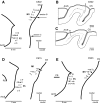

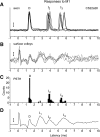
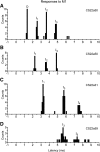
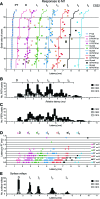
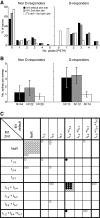
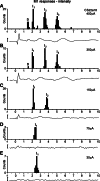
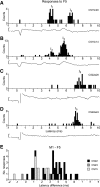
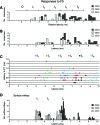
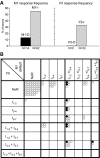
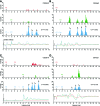

Similar articles
-
Pronounced reduction of digit motor responses evoked from macaque ventral premotor cortex after reversible inactivation of the primary motor cortex hand area.J Neurosci. 2008 May 28;28(22):5772-83. doi: 10.1523/JNEUROSCI.0944-08.2008. J Neurosci. 2008. PMID: 18509039 Free PMC article.
-
Differences in the corticospinal projection from primary motor cortex and supplementary motor area to macaque upper limb motoneurons: an anatomical and electrophysiological study.Cereb Cortex. 2002 Mar;12(3):281-96. doi: 10.1093/cercor/12.3.281. Cereb Cortex. 2002. PMID: 11839602
-
Macaque ventral premotor cortex exerts powerful facilitation of motor cortex outputs to upper limb motoneurons.J Neurosci. 2004 Feb 4;24(5):1200-11. doi: 10.1523/JNEUROSCI.4731-03.2004. J Neurosci. 2004. PMID: 14762138 Free PMC article.
-
Functional differences in corticospinal projections from macaque primary motor cortex and supplementary motor area.Adv Exp Med Biol. 2002;508:425-34. doi: 10.1007/978-1-4615-0713-0_48. Adv Exp Med Biol. 2002. PMID: 12171139 Review.
-
The contribution of transcranial magnetic stimulation in the functional evaluation of microcircuits in human motor cortex.Front Neural Circuits. 2013 Feb 13;7:18. doi: 10.3389/fncir.2013.00018. eCollection 2013. Front Neural Circuits. 2013. PMID: 23407686 Free PMC article. Review.
Cited by
-
Starting and stopping movement by the primate brain.Brain Neurosci Adv. 2019 Mar 15;3:2398212819837149. doi: 10.1177/2398212819837149. eCollection 2019 Jan-Dec. Brain Neurosci Adv. 2019. PMID: 32166180 Free PMC article.
-
Motor Cortex Inputs at the Optimum Phase of Beta Cortical Oscillations Undergo More Rapid and Less Variable Corticospinal Propagation.J Neurosci. 2020 Jan 8;40(2):369-381. doi: 10.1523/JNEUROSCI.1953-19.2019. Epub 2019 Nov 21. J Neurosci. 2020. PMID: 31754012 Free PMC article.
-
Clinical Pearls and Methods for Intraoperative Motor Mapping.Neurosurgery. 2021 Feb 16;88(3):457-467. doi: 10.1093/neuros/nyaa359. Neurosurgery. 2021. PMID: 33476393 Free PMC article. Review.
-
Axon diameters and conduction velocities in the macaque pyramidal tract.J Neurophysiol. 2014 Sep 15;112(6):1229-40. doi: 10.1152/jn.00720.2013. Epub 2014 May 28. J Neurophysiol. 2014. PMID: 24872533 Free PMC article.
-
Two different mirror neuron networks: The sensorimotor (hand) and limbic (face) pathways.Neuroscience. 2017 Sep 1;358:300-315. doi: 10.1016/j.neuroscience.2017.06.052. Epub 2017 Jul 4. Neuroscience. 2017. PMID: 28687313 Free PMC article. Review.
References
-
- Amassian VE, Stewart M, Quirk GJ, Rosenthal JL. Physiological basis of motor effects of a transient stimulus to cerebral cortex. Neurosurgery 20: 74–93, 1987 - PubMed
-
- Borra E, Belmalih A, Gerbella M, Rozzi S, Luppino G. Projections of the hand field of the macaque ventral premotor area F5 to the brainstem and spinal cord. J Comp Neurol 518: 2570–2591, 2010 - PubMed
-
- Borchers S, Himmelbach M, Logothetis N, Karnath HO. Direct electrical stimulation of human cortex–the gold standard for mapping brain functions? Nat Rev Neurosci 13: 63–70, 2012 - PubMed
-
- Butovas S, Schwarz C. Spatiotemporal effects of microstimulation in rat neocortex: a parametric study using multielectrode recordings. J Neurophysiol 90: 3024–3039 200 - PubMed
-
- Cerri G, Shimazu H, Maier MA, Lemon RN. Facilitation from ventral premotor cortex of primary motor cortex outputs to macaque hand muscles. J Neurophysiol 90: 832–842, 2003 - PubMed
Publication types
MeSH terms
Grants and funding
LinkOut - more resources
Full Text Sources
Other Literature Sources
Miscellaneous

